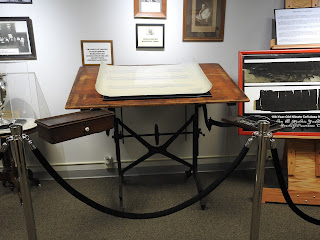Call it dumb luck, call it serendipity, call it the hand of God. Any way you look at it, it worked out perfectly. First of all, we suffered brain fade and accidentally stayed an extra night in our last park, which in theory threw the whole remainder of the (pre-paid) trip off by a day. On the plus side, we didn’t break camp in a downpour, but beyond that, the slide malfunction would have meant that the slide was partially deployed (and unsealed) in the deluge. In addition, the next day was sunny for our drive to Blue Springs Campground in Lee’s Summit, where we waited over the weekend for parts. Instead of checking out on Saturday, we were delayed till Tuesday (assuming the parts actually came in). The down time allowed for a laundry day, the last one of this trek. The repair was completed on Monday as we hoped. The bad slide motor electrical wires and the whole unit was found to be dripping with water, thus shorting it out. How this happened will forever remain a mystery but George, our repair guy, says he has seen it all, including that. This whole comedy of errors shorted us by a day on the front end and added two days on the back end to allow for sight-seeing in Kansas City after all! And as of tomorrow, the entire trip will be back on schedule! (We even got a senior discount on our extra 2 nights in Lee’s Summit!) (Frankly, I don’t consider it, “lucky,” to have time to do laundry…) Uh oh. When I double-checked the itinerary, I found that I had made our reservation at our next stop for June instead of July! So we didn’t have a place to stay next! Shit! But we contacted Jennifer in Hutchinson, KS and she said we were not charged for those days because we didn’t actually show up! However, she does have a slot for us for a one-nighter on Tuesday, so we’ll be off like a prom dress!
 |
| Noobee and the Jeepster in site 59, Blue Springs Campground |
 |
| I guess if you have to be delayed by a few days, this is the place to be! |
Where did the word, “Kansas,” come from? The Kansa Indian tribe, the Kansas, lived
nearby. Thus, Kansas City. It is nicknamed, “The City of
Fountains.” There are 200 fountains in
KC, second only in number in Rome, Italy.
Our guide, Trolley Tom, drove by many of them on our Sunday tour. The Henry Wollman Block (as in H. & R.
Block) fountain is in front of Union Station where we were to board our
trolley.
When Rob made our tour reservation, it was suggested that we plan time to walk inside Union Station. It is massive and a monumental achievement designed by architect Jarvis Hunt. Construction began on August 27, 1910 and it took 4 years to complete. The floor plan is 850,000 sq. ft., the ceilings are 95 ft. high in the Grand Hall, the clock face is 6 ft. in diameter and each chandelier weighs in at 3,500 lb.
 |
| Passenger Hall then |
 |
| Passenger Hall now - Along the sides, you see the doorways to the stairways down to the tracks. |
To the side is another massive hall where folks sat waiting to board their trains on 16 tracks down below. In size, this station is second only to Grand Central Station in NY. In the center of the Grand Hall is the ticketing booth. As you can imagine, it is huge and now, it is the location of Harvey House Restaurant. Created by Fred Harvey in the mid-1800s, Harvey thought train food was disgusting, inedible and the service sucked. He made a deal with the Santa Fe Railroad to operate eateries along their lines. The food was exceptional and he hired and trained good-looking single women, “of good character,” to serve meals. They became known as, “Harvey Girls.” Harvey kicked ass and it was a class act.
 |
| Escalator and stairway down to the lower level |
 |
| 3,500 lb. chandelier |
 |
| Walt Disney is an icon in Kansas City |
 |
| Union Station and the Block Fountain |
 |
| Grand Hall and the Ticket Office - Now, Harvey's House Restaurant |
 |
| Harvey Girl's uniform (A Harvey Girl had to agree not to marry for 6 months after being hired.) |
 |
| Lindy in Union Station |
Steamboat Arabia was built in 1851 and transported passengers and cargo up and down the unruly Missouri River. In 1856, the sidewheeler and a fallen underwater tree had a run-in and the tree won. All of the 150 passengers and crew survived but the steamboat and all of its cargo were swallowed up quickly by the Missouri and covered with silt and muck. No one ever saw the boat again until 132 years later when it was found 45 feet underground ½ mile from the Missouri River after it changed course. It was uncovered and restored and every item in it was found to be perfectly preserved including clothing, china, food (including canned fruit and pickles) and wine. (I’d be happy to try the wine. The food, not so much.) Parts of the ship were also recovered including the machinery and the paddlewheel and all can be seen at the Steamboat Arabia Museum.
 |
| Steamboat Arabia |
To be continued -






































.JPG)



.jpg)